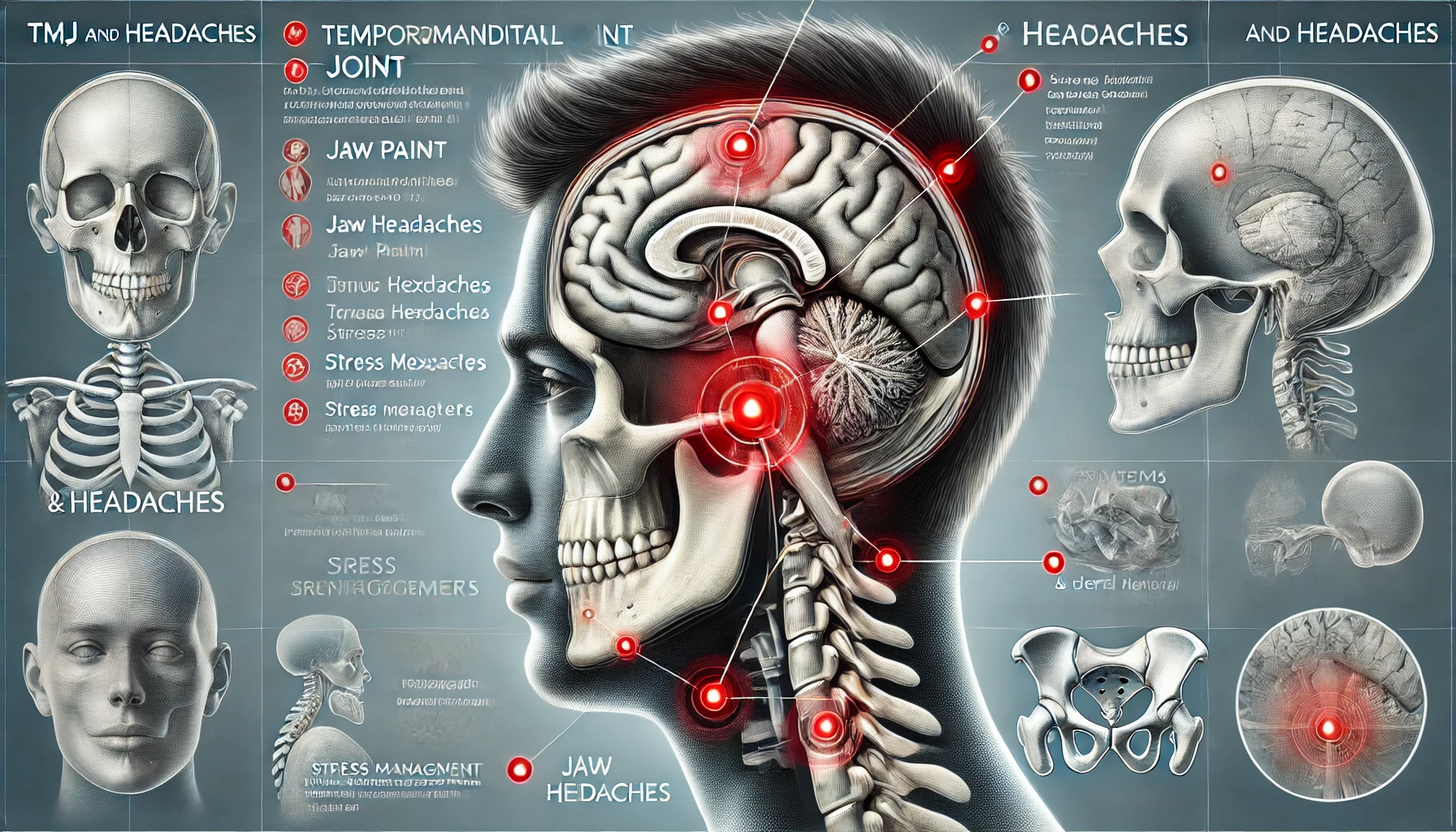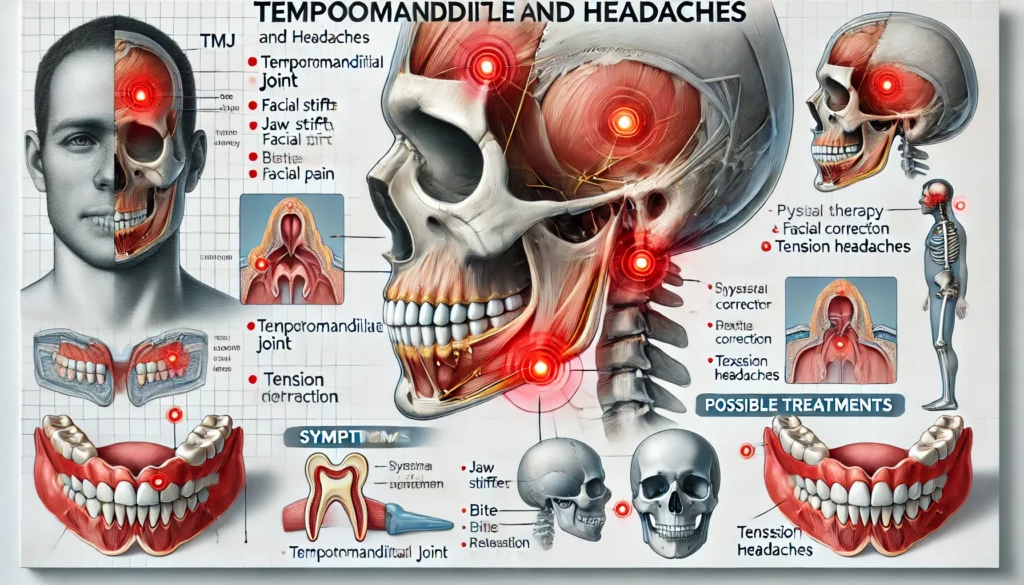
26 Mar TMJ and Headaches – Jaw Pain and Headaches!
If you’ve ever experienced frequent headaches alongside jaw pain or discomfort, you might be dealing with a condition called temporomandibular joint (TMJ) disorder. TMJ is a common issue that affects the jaw joint, and it is often linked to headaches. In this article, we will explore the connection between TMJ and headaches, the symptoms, and the best treatment options to help you find relief.
What is TMJ and How Does it Relate to Headaches?
The temporomandibular joint (TMJ) connects your jawbone to your skull, allowing you to open and close your mouth. When this joint becomes irritated or dysfunctional, it leads to TMJ disorder, which can cause pain, stiffness, and clicking sounds in the jaw. TMJ disorder can also trigger a variety of symptoms, including headaches.
The connection between TMJ and headaches lies in the fact that the muscles around the jaw and head are closely connected. When there is dysfunction in the jaw joint, it can cause muscle tension, which leads to tension headaches or even migraines. This can result in headaches that may feel like they are originating from the temples or the back of the head.
Read Also: Perimenopause Headaches – Headaches During Perimenopause!
Common Symptoms of TMJ-Related Headaches
TMJ-related headaches often present with a range of symptoms, and recognizing them can help you determine whether your headaches are linked to TMJ. Some common symptoms include:
- Jaw Pain or Tenderness: Pain in the jaw, especially when chewing, yawning, or speaking.
- Clicking or Popping Sounds: You might hear a clicking or popping noise when opening or closing your mouth.
- Ear Pain or Ringing: TMJ can cause discomfort in the ears, sometimes accompanied by a ringing sound (tinnitus).
- Neck and Shoulder Tension: Muscle tightness or discomfort in the neck and shoulders can also accompany TMJ headaches.
- Frequent Headaches: Headaches that feel like tension or migraines, often occurring around the temples, forehead, or the back of the head.
How TMJ Causes Headaches
TMJ disorder can cause headaches in a few different ways:
- Muscle Tension: The muscles responsible for jaw movement can become strained due to TMJ, leading to tightness and pain that radiates to the head, causing headaches.
- Jaw Misalignment: If the jaw is misaligned due to TMJ, it can put pressure on surrounding nerves and muscles, triggering headaches.
- Grinding and Clenching: People with TMJ disorder often grind or clench their teeth, particularly at night, which can lead to tension headaches and even migraines.
- Posture Issues: TMJ can affect posture, especially in the neck and shoulders, which may further contribute to headache symptoms.
How to Treat TMJ and Headaches
Managing TMJ disorder and the associated headaches requires a combination of lifestyle changes, therapy, and sometimes medical intervention. Here are some effective treatment options:
- Jaw Exercises and Physical Therapy: Gentle exercises to relax and stretch the jaw muscles can help alleviate pain. Physical therapy can also help improve posture and reduce muscle tension in the neck and shoulders.
- Mouthguards or Splints: A custom-made mouthguard or dental splint can help prevent teeth grinding or clenching, especially during sleep. This can reduce the pressure on the jaw and decrease headache frequency.
- Stress Management: Since stress is a common trigger for both TMJ and headaches, practicing stress-reducing techniques such as meditation, deep breathing, or yoga can help reduce symptoms.
- Pain Relievers: Over-the-counter pain medications such as ibuprofen or acetaminophen can help manage the pain caused by TMJ and headaches. In more severe cases, your doctor may prescribe stronger medications or muscle relaxants.
- Hot or Cold Compresses: Applying a warm compress to the jaw or a cold compress to the forehead can help alleviate muscle tension and reduce headache symptoms.
- Chiropractic Care: Some people find relief from TMJ-related headaches with chiropractic care, which can help align the jaw and improve overall posture.
The Impact of Poor Posture on TMJ and Headaches

Poor posture can contribute significantly to both TMJ and headaches. Slouching or hunching over, especially during activities like sitting at a desk or using a phone, places extra stress on the neck and jaw muscles. This poor alignment can exacerbate TMJ symptoms, leading to increased muscle tension and jaw pain. Additionally, poor posture can trigger or worsen tension headaches due to the added strain on the muscles and nerves in the upper back, neck, and shoulders. Maintaining proper posture throughout the day can help reduce the risk of TMJ-related headaches.
How Diet Can Influence TMJ and Headache Symptoms
What you eat may also play a role in your TMJ disorder and headaches. Certain foods, such as those high in sugar or caffeine, can contribute to muscle tension and inflammation, making TMJ symptoms worse. For example, caffeine can increase muscle tightness, while sugary foods can lead to blood sugar fluctuations that may trigger headaches. On the other hand, a balanced diet rich in anti-inflammatory foods like leafy greens, fatty fish, and nuts can help reduce muscle tension and support overall joint health. Drinking plenty of water and avoiding foods that contribute to jaw clenching or grinding can also help manage TMJ and related headaches.
TMJ and Headaches: When to Consider Professional Treatment
While at-home remedies like jaw exercises and stress management can offer relief for many, some individuals may require professional treatment to manage TMJ and headaches effectively. A dentist specializing in TMJ disorders can design a custom mouthguard or splint to help prevent teeth grinding and relieve pressure on the jaw. For more severe cases, physical therapy, chiropractic care, or even injections may be recommended to reduce pain and inflammation. If your headaches persist despite self-care methods, consulting a healthcare provider is essential to explore more targeted and specialized treatment options for long-term relief.
When to See a Doctor for TMJ and Headaches
If your headaches are frequent or severe and are accompanied by jaw pain, clicking sounds, or difficulty moving your jaw, it’s important to consult with a healthcare professional. A dentist or doctor can diagnose TMJ disorder and recommend appropriate treatment options tailored to your needs. Early intervention can help prevent long-term complications and improve your quality of life.
FAQs:
1 What is the connection between TMJ and headaches?
TMJ causes muscle tension, jaw misalignment, and teeth grinding, which can lead to headaches, particularly tension and migraine-type headaches.
2 How can TMJ-related headaches be treated?
Treatment includes jaw exercises, mouthguards, stress management, physical therapy, pain medications, and hot or cold compresses.
3 Can stress cause TMJ and headaches?
Yes, stress is a common trigger for both TMJ symptoms (like teeth grinding) and headaches, particularly tension headaches.
4 What are the common symptoms of TMJ disorder?
Symptoms include jaw pain, clicking sounds when opening the mouth, headaches, ear pain, neck and shoulder tension, and difficulty chewing.
5 When should I see a doctor for TMJ and headaches?
If headaches and jaw pain are frequent, severe, or interfere with daily life, it’s important to consult a healthcare professional for diagnosis and treatment.
Conclusion:
TMJ disorder is a common yet often overlooked cause of headaches, and addressing the underlying jaw issues can significantly reduce headache symptoms. If you’re struggling with TMJ and headaches, there are many treatment options available that can help relieve pain and improve your overall well-being. By practicing jaw relaxation techniques, managing stress, and seeking professional care when necessary, you can find relief and prevent future discomfort.

No Comments